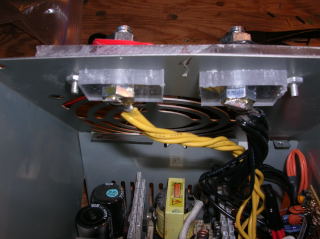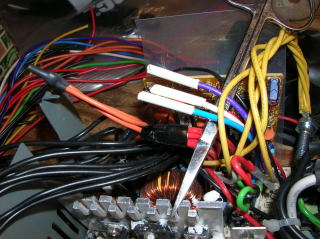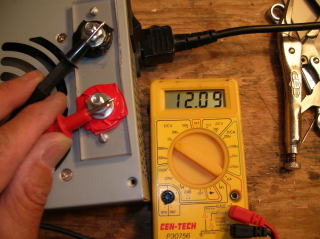
Modifying an "ATX" Type Personal Computer Power Supply To Run Your Direct Current RC Battery Charger.
You can use an old personal computer power supply to run your direct current RC battery charger. This is useful when you want to charge or cycle a battery pack at home on the bench. You can usually obtain an "ATX" type supply and power cord from the computer support person where you work. They usually have a big cardboard box of these and are happy to get rid of them. Take these instructions in with you so he can get you one just like these pictures.
These instructions are meant to complement the more extensive ones written by Pat Harvey. These are posted on the R/C battery clinic web site:
http://www.rcbatteryclinic.com/
click on "PC Power Supply for Chargers by Pat Harvey"
Pat’s instructions cover all types of power supplies, and provide methods for identifying the correct wires if the colors are non-standard. This makes things seem complicated. But keep in mind that only six solder joints are needed to set up an "ATX" type supply. The descriptions below are accompanied by pictures showing each step.
You will need a 25-watt 2-ohm resistor (or a 12 volt auto tail light bulb) and a large soldering iron.
When you are done you will have a power supply that looks like this:

Getting Started:
Position the power supply with the switch to the right.
Take the four screws out of the top that hold the fan to the case.
Take the four screws out of the top that hold the top of the case to the bottom.
Remove the top of the supply and set it aside; move the fan to the back.
Cut the nylon cable ties and remove the black grommet to free up all the wires
Getting the Fan to Run:
Locate the green "power good" wire. Cut this as shown and solder it to one of the black "common" wires.

Now locate the single grey "power supply on" wire and solder it to one of the red + 5 volt wires.

You will now be able to plug in the supply, turn on the switch and the fan will run. Don’t stick your hands into the wires when you do this test. Unplug the unit and put heat shrink tubing on both solder joints to insulate them.

Getting A Full 12 Volts:
These power supplies must have a load on the 5-volt side to generate a full 12 volts. You will need to get a 25 watt 2 ohm resistor from the electronics parts store.

Cut a black "common" wire and a red +5 volt wire to about 8" long.
Put some heat shrink tubing on each wire.
Solder a black "common" wire to one lead of the resistor and a red +5 volt wire to the other.
Shrink the tubing.

Place the resistor down into the bottom of the case and wedge the wires under the printed circuit board so the resistor doesn’t rattle around. If you can't find the proper sized resistor, a 12 volt auto tail light bulb will do just as well. Install it outside of the case to avoid heat buildup.

(Note the location of the fuse in case you ever have to replace this.)

Insulated Support for the Main Terminals:
Now we need to provide insulated support for our two terminals. I used some clear Lexan type plastic I found in a dumpster, but any non-conductive material should work.

Drill two ½" holes in the top of the case to provide clearance for the two bolts that you’ll use for terminals. I used 1½" long ¼-20 stove bolts, washers, and nuts. Drill holes at the ends for machine screws and nuts to hold the insulator in place. Drill ¼" holes in the plastic insulator at this time.

You will also need to cut and drill some plastic to insulate the bolt from the inside of the case. I like to use small rectangles of plastic like in the picture. These should be thin on one side to provide clearance for the flange on the bottom of the case, about 3/8" or so. Test fit these.

Grind off the plating on each bolt head to make the solder stick better.

And tin both bolt heads with solder.

The Main 12-Volt Lines:
Now gather up all of the yellow +12 volt wires. Estimate how much wire will be needed to reach the positive red terminal and allow a couple of inches extra. Cut the 12-volt wires and solder to one of the bolt heads.
Next, gather up all of the rest of the black "common" wires. Estimate how much wire will be needed to reach the negative black terminal and allow couple of inches extra. Cut the black wires and solder to one the other bolt head.

When you have soldered both of these, it should look something like this:

Assemble each of the terminals. Wrap large washers with red and black electrical tape to correctly identify the positive (red) and negative (black) terminals. Note the clearance between the inside insulators and the edge of the case.

Next cut all the rest of the unused wires short and insulate with heat shrink or electrical tape so nothing will short out. Bend them down out of the way.

Final Assembly and Testing:
Reassemble the case, fan first. Carefully position the yellow and black wire bundles around the fan and heat sinks as you do this.

Now carefully plug in the finished power supply and test the voltage with a voltmeter.

Finally, hook up your charger and try it out.
